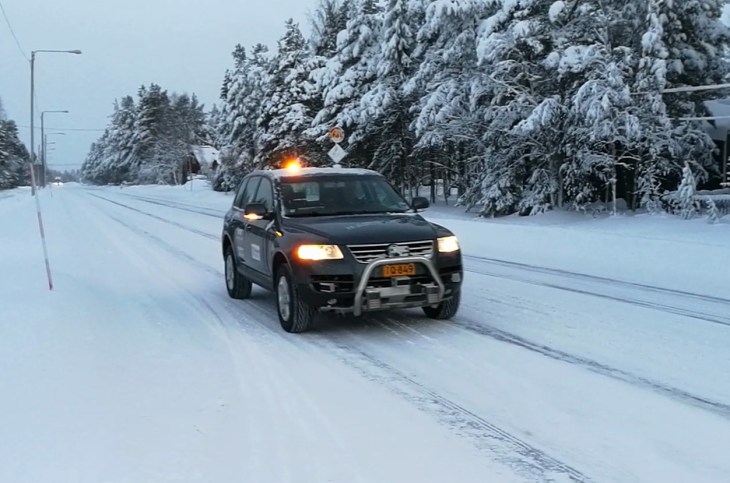Testing for the Future of Autonomous Vehicles
"The testing in Silicon Valley and Arizona, it's interesting, but something very different from the environment we have here."
"And we thought, if we don't do this kind of development now -- looking at how automated vehicles could work in our harsh environments -- then we're going to miss out on the benefits of automated driving, things like traffic safety improvement, improved efficiencies and bringing down emissions."
"Current technology is known to have limitations in challenging and varying conditions, which includes heavy rain, fog, dark enclosed spaces, slippery surfaces, and snowfall."
"Regardless of the [Uber] incident, we know that winter testing remains a very important development to make automated driving possible for people living in more wintry regions throughout the world."
"AV [automated vehicle] developers need to clearly explain what they're doing, why they believe it is reasonably safe, and why we as authorities should believe them."
"It is important to be up-front about the potential challenges and failures, and testing organizations should actively aim to mitigate the harms caused by any failures."
"It's important for us to show that autonomous vehicles will be resilient to different kinds of conditions, whether it's heavy rain, snow or ice. That is the core question if we really want to see the market changing and people accepting, using, and buying automated vehicles."
Alina Koskela, Transport Ministry manager, Aurora Project, Finland
"[Video evidence] strongly suggests a failure by Uber's automated driving system and a lack of due care by Uber's driver [and by the victim in the March 2018 fatal crash in Tempe Arizona]."
""[The vehicle's sensors] absolutely should have detected her and classified her as something other than a stationary object."
Professor Bryant Walker Smith, autonomous driving, University of South Carolina
A ten-kilometre stretch of a public highway located in the Arctic Circle is a venue being used by the Finnish government for autonomous vehicle testing. The remote highway, often dark, and for at least six months of the year covered in ice and snow was opened in 2016 for testing, named the Aurora Project. The government of Finland spent close to $8-million to develop the project now in action. Anyone is welcome to test autonomous vehicle technology on the E8 highway stretching across the border into Norway.
 |
| The world’s first Arctic test ecosystem for intelligent transport systems and automated driving is being built in Finnish Lapland. |
Once there, across the border, the Borealis Project is reached, where testing on the Norwegian side also takes place, administered by the Norwegian Public Road Administration. Everywhere on the planet where governments anticipate the eventual distribution and use of autonomous vehicles, the image of the death caused by an Uber vehicle haunts the minds of those tasked with researching the issue of the technology passing all user and safety tests. Questions remain to be answered, among them how is it that the Lidar and radar sensors of the vehicle failed to distinguish the woman crossing the road?
This accident occurred on a clear, paved road. This was a warm evening in Arizona. Yet such an accident occurred as a startling fatality when the concept of autonomous vehicles is meant to promise greater safety in highway traffic, with intelligent vehicles engineered to avoid all faults inherent in human carelessness. So if such an accident could occur when all environmental issues have been set aside in a normal landscape, what happens when an autonomous vehicle steers through icy roads and whiteout conditions with blustery winds?
Northern countries like Finland and Norway are practising due diligence and preparing for the future of automated vehicles. Another northern country, Canada, appears to be lagging behind, although the province of Ontario has made accommodation for practise runs of AVs to do their research on safety without much in the way of government involvement. The Information and Communications Technology Council released a January report stating Canada must commit to working toward meeting the level of the world's key AV developers.
 |
| Finland wants to become a world pioneering test and development environment for intelligent automation in transport. Reija Viinanen reminds that automated driving solutions have to also work in winter conditions Aurora |
In November, an autonomous vehicle testing zone was put in place in Stratford, Ontario to enable automakers to test their self-driving vehicles in harsh winter conditions common to Canada. Michigan, U.S., sees similar testing being done, as well. But nothing comes anywhere close to what the Aurora Project has uniquely committed to. The highway, heavily utilized by transport trucks ferrying Norwegian salmon to Helsinki, was developed into an "intelligent road". The Finnish government installed sensors in the road to measure vibration, weight, pressure, acceleration and surface tension.
This accommodation is enabling of optimizing testing and in the process providing information about highway driving in very particular conditions common to Siberian cold fronts. The data provided to researchers has the potential to further develop autonomous vehicle technology. Martti, a Volkswagen Touareg with three laser scanners drove on a snow-covered highway, no road markers visible, at 40 km/h, though higher speeds could have been used. Although experts feel we are decades away from seeing AVs on the road, snow testing remains a priority and for obvious reasons.
 |
| Martti is one of two cars designed by VTT Technical Research Center; it’s designed to handle rough and icy conditions |
Labels: Autonomous Vehicles, Finland

<< Home